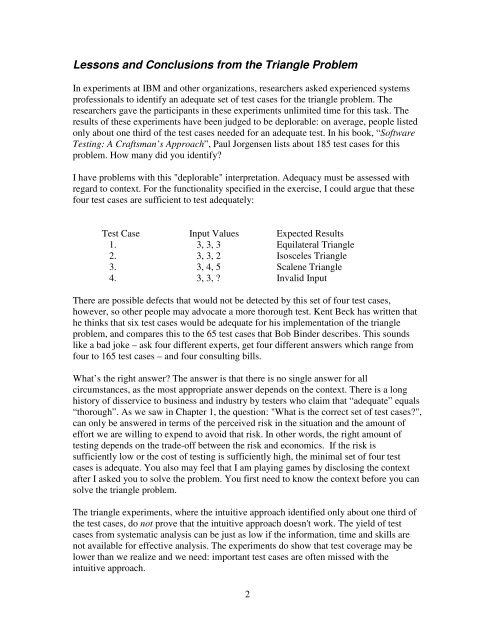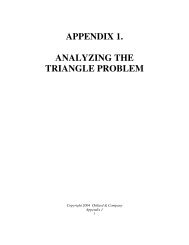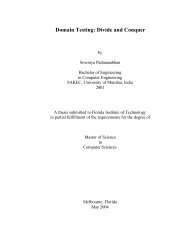Exercise: Analyzing the Triangle Problem - Testing Education
Exercise: Analyzing the Triangle Problem - Testing Education
Exercise: Analyzing the Triangle Problem - Testing Education
Create successful ePaper yourself
Turn your PDF publications into a flip-book with our unique Google optimized e-Paper software.
Lessons and Conclusions from <strong>the</strong> <strong>Triangle</strong> <strong>Problem</strong><br />
In experiments at IBM and o<strong>the</strong>r organizations, researchers asked experienced systems<br />
professionals to identify an adequate set of test cases for <strong>the</strong> triangle problem. The<br />
researchers gave <strong>the</strong> participants in <strong>the</strong>se experiments unlimited time for this task. The<br />
results of <strong>the</strong>se experiments have been judged to be deplorable: on average, people listed<br />
only about one third of <strong>the</strong> test cases needed for an adequate test. In his book, “Software<br />
<strong>Testing</strong>: A Craftsman’s Approach”, Paul Jorgensen lists about 185 test cases for this<br />
problem. How many did you identify?<br />
I have problems with this "deplorable" interpretation. Adequacy must be assessed with<br />
regard to context. For <strong>the</strong> functionality specified in <strong>the</strong> exercise, I could argue that <strong>the</strong>se<br />
four test cases are sufficient to test adequately:<br />
Test Case Input Values Expected Results<br />
1. 3, 3, 3 Equilateral <strong>Triangle</strong><br />
2. 3, 3, 2 Isosceles <strong>Triangle</strong><br />
3. 3, 4, 5 Scalene <strong>Triangle</strong><br />
4. 3, 3, ? Invalid Input<br />
There are possible defects that would not be detected by this set of four test cases,<br />
however, so o<strong>the</strong>r people may advocate a more thorough test. Kent Beck has written that<br />
he thinks that six test cases would be adequate for his implementation of <strong>the</strong> triangle<br />
problem, and compares this to <strong>the</strong> 65 test cases that Bob Binder describes. This sounds<br />
like a bad joke – ask four different experts, get four different answers which range from<br />
four to 165 test cases – and four consulting bills.<br />
What’s <strong>the</strong> right answer? The answer is that <strong>the</strong>re is no single answer for all<br />
circumstances, as <strong>the</strong> most appropriate answer depends on <strong>the</strong> context. There is a long<br />
history of disservice to business and industry by testers who claim that “adequate” equals<br />
“thorough”. As we saw in Chapter 1, <strong>the</strong> question: "What is <strong>the</strong> correct set of test cases?",<br />
can only be answered in terms of <strong>the</strong> perceived risk in <strong>the</strong> situation and <strong>the</strong> amount of<br />
effort we are willing to expend to avoid that risk. In o<strong>the</strong>r words, <strong>the</strong> right amount of<br />
testing depends on <strong>the</strong> trade-off between <strong>the</strong> risk and economics. If <strong>the</strong> risk is<br />
sufficiently low or <strong>the</strong> cost of testing is sufficiently high, <strong>the</strong> minimal set of four test<br />
cases is adequate. You also may feel that I am playing games by disclosing <strong>the</strong> context<br />
after I asked you to solve <strong>the</strong> problem. You first need to know <strong>the</strong> context before you can<br />
solve <strong>the</strong> triangle problem.<br />
The triangle experiments, where <strong>the</strong> intuitive approach identified only about one third of<br />
<strong>the</strong> test cases, do not prove that <strong>the</strong> intuitive approach doesn't work. The yield of test<br />
cases from systematic analysis can be just as low if <strong>the</strong> information, time and skills are<br />
not available for effective analysis. The experiments do show that test coverage may be<br />
lower than we realize and we need: important test cases are often missed with <strong>the</strong><br />
intuitive approach.<br />
2








